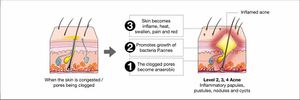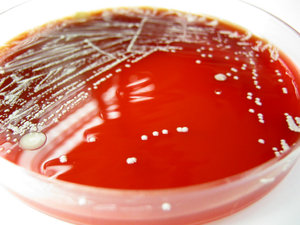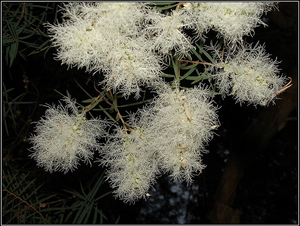Tea Tree Oil and its Effectiveness in Treating Acne Vulgaris: Difference between revisions
Asherida8824 (talk | contribs) No edit summary |
Asherida8824 (talk | contribs) No edit summary |
||
| Line 13: | Line 13: | ||
There are multiple mechanisms by which acne lesions can be formed. Such mechanisms include the release of inflammatory mediators into the skin, changes in sebum production, a modification to the process leading to the formation of comedones, and a colonization of the bacteria species ''Propionibacterium acnes'' [http://www.ncbi.nlm.nih.gov/pubmed/21880356 <sup>5</sup>.] | There are multiple mechanisms by which acne lesions can be formed. Such mechanisms include the release of inflammatory mediators into the skin, changes in sebum production, a modification to the process leading to the formation of comedones, and a colonization of the bacteria species ''Propionibacterium acnes'' [http://www.ncbi.nlm.nih.gov/pubmed/21880356 <sup>5</sup>.] | ||
[[Image:Plate of Propionibacterium Acnes.png|thumb|300px|right|Colonies of ''Propionibacterium acnes'' growing on an agar plate. Photograph taken by mostly*harmless. 27 August 2013. Online Image. Flickr. https://www.flickr.com/photos/21997898@N04/9603563911/in/photolist-fCCLY8-fCVmCU-fCCLUT-9w7obf-9FKCaN-dkYQQZ-9CYVBC-9CVZmD-9CYVjC-9CVZHp-9w7osG-9CVZtV-9w7oob-9w7orj-9CVZSr-9CVZNa-9w4mrc-9w7nVL-9w7ohJ-9w4my8-9w7nkA-9w4kVa-9w4m5v-9w4moD-gHsHoM-ag6dJr-ag6dAn.]] | [[Image:Plate of Propionibacterium Acnes.png|thumb|300px|right|Colonies of ''Propionibacterium acnes'' growing on an agar plate. Photograph taken by mostly*harmless. 27 August 2013. Online Image. Flickr. https://www.flickr.com/photos/21997898@N04/9603563911/in/photolist-fCCLY8-fCVmCU-fCCLUT-9w7obf-9FKCaN-dkYQQZ-9CYVBC-9CVZmD-9CYVjC-9CVZHp-9w7osG-9CVZtV-9w7oob-9w7orj-9CVZSr-9CVZNa-9w4mrc-9w7nVL-9w7ohJ-9w4my8-9w7nkA-9w4kVa-9w4m5v-9w4moD-gHsHoM-ag6dJr-ag6dAn.]] | ||
===''Propionibacterium acnes''=== | ===''Propionibacterium acnes''=== | ||
Revision as of 10:25, 15 April 2014
Recent studies indicate that traditional antibiotic treatment may not be as effective in treating this disease, thus a growing concern has arisen and essential oils have been targeted as a potential antimicrobial treatment option.
Introduction to Acne Vulgaris

Acne vulgaris is a skin disease that affects more than half of the population at one point or another during their lifetime. Acne vulgaris may be most prevalent during adolescent years and development, however certain strains can persist through adulthood. The clinical features and prevalence of acne vulgaris have gained increased attention in more recent years. Acne vulgaris, or common acne, involves the pilosebaceous unit. Pilosebaceous units are hair follicles in the skin that are associated with an oil gland 5. Generally speaking, acne arises during puberty and resolves prior to adulthood. However, there are some variations or factors that persist long into adulthood.
Seborrhea, comedones, papules and pustules are clinical features that distinguish acne from other diseases 5. Seborrhoea is defined as excess grease while comedones are a result of a clogged hair follicle 5. Comedones are manifested as either blackheads or white heads and are distinguishable by whether or not they are covered or open. Blackheads are open comedones while white heads are closed. Lastly, papules and pustules are categorized as inflammatory lesions and constitute final clinical features of acne 5. Both are distinguished by an elevation of the skin and the production of pus.
Acne is typically found in parts of the body where there is a high density of pilosebaceous units 5. Specific body parts include the face, shoulders, back, neck, arms, and upper chest. The cause of acne can very from one individual to the next and may include, heredity, sweating, diet, and the consumption of certain drugs, and can even be influenced by environmental conditions such as humidity 5.
There are multiple mechanisms by which acne lesions can be formed. Such mechanisms include the release of inflammatory mediators into the skin, changes in sebum production, a modification to the process leading to the formation of comedones, and a colonization of the bacteria species Propionibacterium acnes 5.

Propionibacterium acnes
The genome of Propionibacterium acnes was recently sequenced. The genome sequence reveals numerous proteins that assist P. Acnes in colonizing and residing in human skin under a variety of conditions 1.
Background Information: Tea Tree Oil

Many essential oils have been found to have antimicrobial and antioxidant properties 3. Of these essential oils, tea tree oil (TTO) may be one of the most studied due to its broad spectrum of known activities 3. Tea tree oil comes from Melaleuca alternifolia, a tree species that is native to Australia. The Melaleuca genus has over 230 species (Carson). In its natural habitat of swampy, subtropical, coastal ground, the M. alternifolia tree grows approximately 5 to 8 meters and produces white fluffy flowers like the one pictured to the right (Carson). Via a steam distillation process, the tea tree oil can be isolated from the leaves, twigs, and branches of M. alternifolia 4.
Component Properties of Tea Tree Oil
Tea tree oil is mainly comprised of terpene hydrocarbons 4. Furthermore, tea tree oil is made up of over 100 components that aid in its antimicrobial and antioxidant capabilities. Some of these components include, monoterpenes, sesquiterpenes, and their alcohol derivatives 3.
According to the International Organization for Standardization (ISO) 4730 guidelines, the various components of tea tree oil must be defined and should not exceed certain percentage parameters. Since tea tree oil (TTO) can vary from one batch to the next, the international guidelines set both physical and chemical criteria for each desired chemotype of tea tree oil (Carson). For example, the ISO guidelines dictate that the concentration of terpinen-4-ol should exceed 30% while the concentration of 1,8-cineole should not exceed 15% 4. However, more than just the components terpinene-4-ol and 1,8-cineole make up tea tree oil. Lee and colleagues (2013) note that the composition of devised tea tree oil formulas have included ϒ-Terpinene, α-Terpinene, ρ-Cymene, α-Pinene, and α-Terpineol.
The tea tree oil most commonly used in commercial production is called terpinen-4-ol chemotype (Carson). The antimicrobial activity of tea tree oil is most often associated with the terpinen-4-ol component (Carson).
The Effects of Tea Tree Oil in the Treatment of Acne
As was previously mentioned, the over activation of Propionibacterium acnes results in the formation of inflammatory responses visible on the surface of the skin. Typically, doctors would prescribe antibiotic medication in order to suppress and control the clinical features of acne 4. Examples of such antibiotics include neomycin, tetracycline, and erythromycin 4.
However, in recent years, the emergence of new antibiotic resistant strains has limited the effectiveness of antibiotics in their ability to suppress and treat Propionibacterium acnes. (Enshaieh et al., 2007). Alternative medicines, such as essential oils, have been studied in recent years in order to determine an alternative mechanism by which to combat the symptoms of over activation of P. acnes. Essential oils provide a possible alternative to antibiotic treatment of acne because they have been shown to have antimicrobial and anti-inflammatory responses 4. The medicinal properties of tea tree oil were first discovered in the 1920s by a researcher named Penfold who was conducting a survey of Australia's essential oils with the most economic potential (Carson).
Previous studies have indicated significant differences in the efficacy of tea tree oil compared to placebos and other traditional antibiotic treatments. The percentage of components of each tea tree oil formula can be adjusted to demonstrate varying efficacy against P. acnes. Previous studies have indicated that skin irritation and other side effects can result from varying degrees of percentage components as well as prolonged exposure 4.
The Antimicrobial and Anti Inflammatory Behaviors of Tea Tree Oil
Specific Studies Pertaining to the Efficacy of Tea Tree Oil
Perhaps one of the most well studied antimicrobial activities include that of the tea tree oil component called terpinen-4-ol 4. In their study conducted in 2013, Chia-Jung Lee and colleagues performed an agar well diffusion test in order to determine the minimum inhibitory concentrations of multiple components of tea tree oil, and in effect their effectiveness in suppressing acne. Agar media containing bacterial growth were placed in a petri dish and stainless steel cylinders were dispersed throughout the dish creating wells 4. Among the components that make up tea tree oil, researchers found that terpinen-4-ol, α-terpineol, α-terpinolene, and α-terpinene demonstrated the greatest antimicrobial activities 4. This is evident in the diameter of their inhibition zone and their minimum inhibitory concentration. A specific composition of tea tree oil was created that contained both terpinen-4-ol and 1,8-cineole in varying percentages and their efficacy and antimicrobial activities were monitored 4. Results indicated that the terpinen-4-ol component of tea tree oil had a greater antimicrobial efficacy compared to that of 1,8-cineole 4.
Additional studies have been conducted studying the effects of tea tree oil on acne treatment. In particular, via a double-blind placebo controlled study, Enshaieh and colleagues (2007) found that 5% tea tree oil demonstrated a significant effect in reducing both the inflamed and non-inflamed lesions indicative of acne. The effect of tea tree oil, or other treatments, on acne vulgaris can be measured by assessing the total acne lesion count (TLC) or the acne severity index (ASI). (Enshaieh et al., 2007) Following treatment with tea tree oil, Enshaieh and colleagues (2007) observed that the mean total lesion count (TLC) reduced by 43.64% following treatment with tea tree oil, thus making the efficacy of tea tree oil significantly different from that of the placebo treatment. Furthermore, tea tree oil was found to reduce the mean acne severity index (ASI) by 40.49% while the placebo group demonstrated a 7.04% reduction of ASI (Enshaieh et al. 2007).
Further Reading
[Sample link] Ebola Hemorrhagic Fever—Centers for Disease Control and Prevention, Special Pathogens Branch
References
2. Cellnique Cosmaceutical. (17 March 2010). Cellnique- About Acne. Animation.
4. Gerus, Tatiana. (11 October 2009). Snow in Summer. Photograph.
7. Mostly*harmless. (27 August 2013). Propionibacterium acnes. Photograph.
8. Williams, H.C., Dellavalle, R.P., & Garner, S. (2012). Acne Vulgaris. Lancet, 379, 361-371.
Edited by Alex Sheridan, a student of Nora Sullivan in BIOL168L (Microbiology) in The Keck Science Department of the Claremont Colleges Spring 2014.
